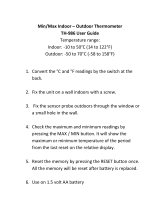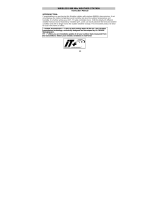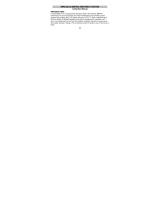
seconds. By doing this, the Weather Station will not mistake the new location as being a possible change in air-
pressure when really it is due to the slight change of altitude. Again, disregard weather forecasts for the next 12 to 24
hours, as this will allow time for operation at a constant altitude.
THE WEATHER TENDENCY INDICATOR
Working together with the weather icons are the weather tendency indicators (located on the top and bottom part of
the weather icons). When the indicator points upwards, it means that the air-pressure is increasing and the weather is
expected to improve, but when indicator points downwards, the air-pressure is dropping and the weather is expected
to become worse.
Taking this into account, one can see how the weather has changed and is expected to change. For example, if the
indicator is pointing downwards together with cloud and sun icons, then the last noticeable change in the weather was
when it was sunny (the sun icon only). Therefore, the next change in the weather will be cloud with rain icons since
the indicator is pointing downwards.
Note: Once the weather tendency indicator has registered a change in air pressure, it will remain permanently
visualized on the LCD.
CHECKING FOR 433 MHz RECEPTION:
In normal surroundings (for example away from interfering sources such as TV sets), the outdoor temperature can
usually be easily received within 1-1/2 minutes. If the outdoor temperature is not displayed on the LCD after 2
minutes, then check the following:
1. The distance of the units should be at least 1.5 - 2.0 meters away from interfering sources such as computer
monitors or TV sets.
2. Avoid placing the units onto or in the immediate proximity of metal doors, window frames or structures.
3. Using other electrical products such as headphones and speakers that operate on the same signal (433 MHz)
can prevent the transmission pick up.
4. Neighbors using electrical products operating on the 433 MHz signal can also cause interference. In most
severe cases, the reception is only possible once all other electrical products using the 433 MHz are switched
off.
5. Within thick concrete rooms such as basements and tower blocks, the 433 MHz signal can be weakened (avoid
placing near metal frames and structures).
6. Transmission can be affected by exposure to extreme temperature conditions. For example, if the weather has
been extremely cold (under -25ºC) for an extended period of time then the transmission signal may be
weakened. (Please bear this in mind when positioning the transmitter).
Note: Should after checking the above list and the outdoor temperature is still not received, then reset the units (see
Resetting the Weather Station below).
RESETTING THE WEATHER STATION:
1. Remove the batteries from the Weather Station and the transmitter(s)
2. Wait at least 30 seconds and repeat the procedures specified in Setting up above.
Note: Remember when resetting, all units have to be reset and to always insert the batteries into the Weather Station
first and then followed by the transmitter(s).













